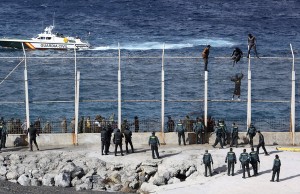NPR Blog
Lauren Frayer

African migrants climb the fence that separates Morocco from the Spanish enclave of Ceuta in North Africa in February. Those who make it into Ceuta have reached Spanish — and European Union — soil. Their fate often depends on the country they came from. Some are deported, while others can apply for political asylum or for the status of economic migrant.
Reduan/EPA/Landov
Listen to the Story
All Things Considered
African migrants climb the fence that separates Morocco from the Spanish enclave of Ceuta in North Africa in February. Those who make it into Ceuta have reached Spanish — and European Union — soil. Their fate often depends on the country they came from. Some are deported, while others can apply for political asylum or for the status of economic migrant.
Reduan/EPA/Landov
On a rocky beach in North Africa, a chain-link fence juts out into the Mediterranean Sea.
This is one of Africa’s two land borders with Europe, at two Spanish cities on the African continent. Ceuta and Melilla are Spanish soil — and thus part of the European Union — separated from the rest of Europe by the Mediterranean, and separated from the rest of Africa by huge fences.
If someone manages to scale those fences, he lands in Europe. Tens of thousands of African and Arab migrants try to do that each year. Many have traveled hundreds of miles already, mostly from sub-Saharan Africa, but also from conflict zones like Syria or Somalia. Their journeys are similar to those many Latino migrants make northward to the U.S.-Mexico border.







